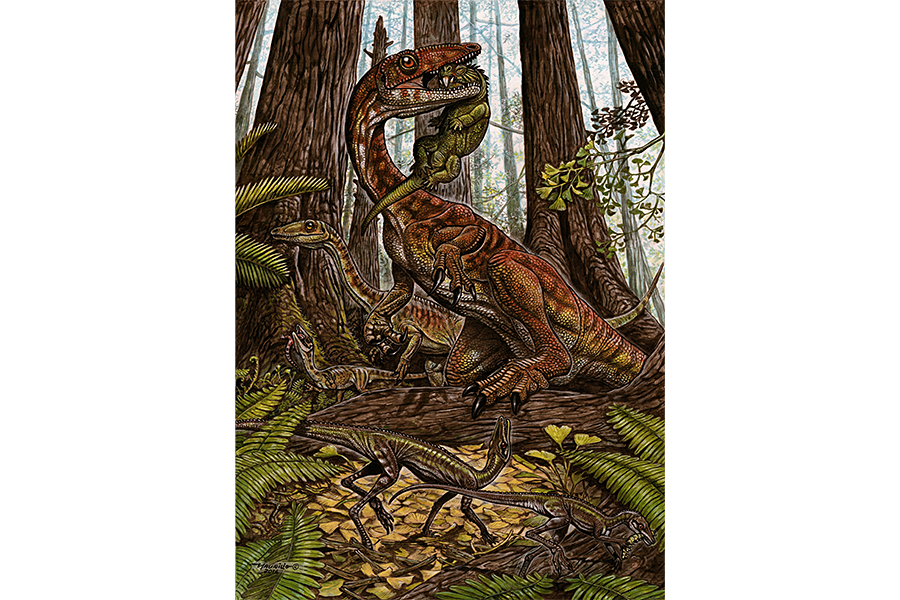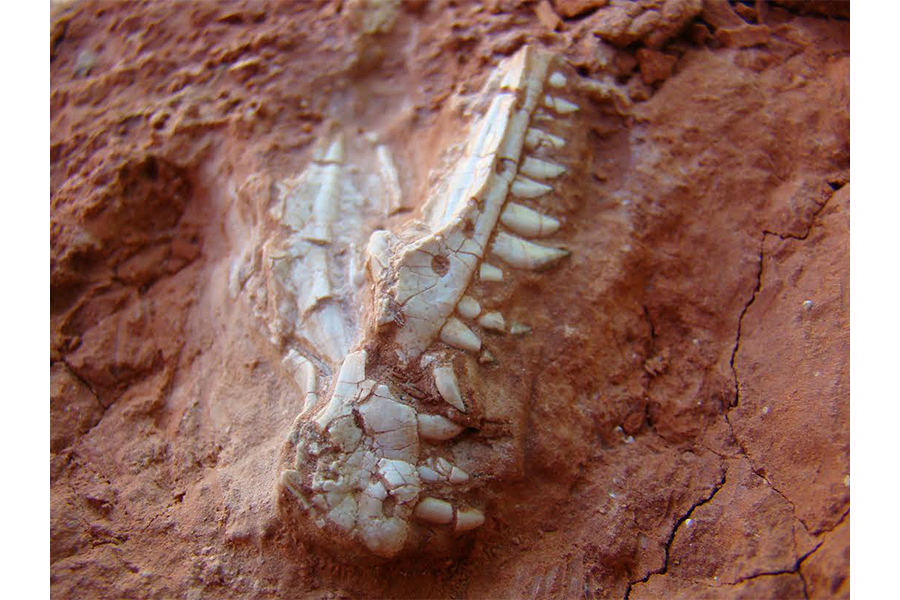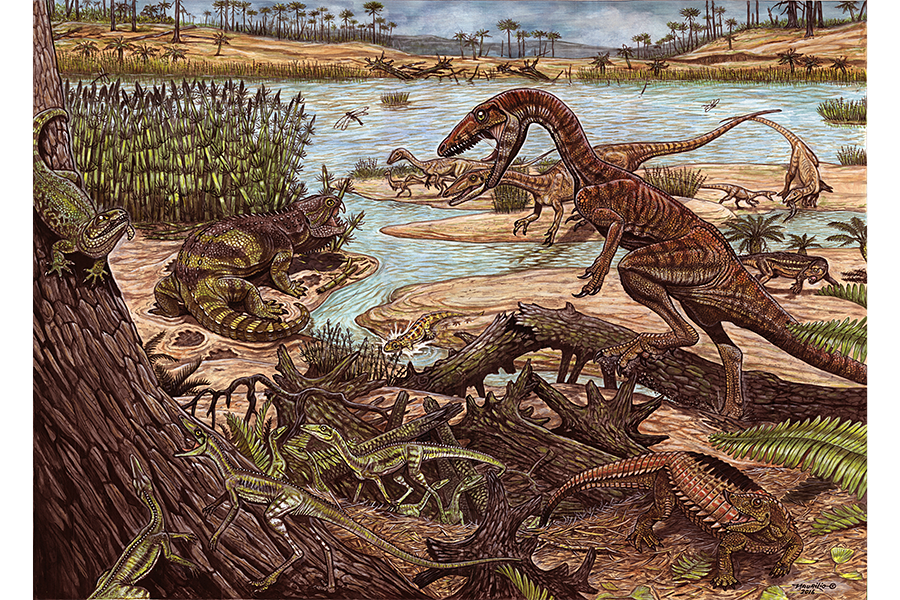Did dinosaurs and their precursors coexist?
Loading...
Before the dinosaurs, there were the lagerpetids. These ancient creatures belonged to a separate lineage of reptiles in the clade dinosauromorpha, and they resembled their famous cousins in many ways despite lacking some distinctive dinosaur features.
These dinosaur precursors of sorts are thought to have emerged around 236 to 234 million years ago, with dinosaurs hot on their heels. But what happened to the lagerpetids when the dinosaurs came along?
Some paleontologists suggested that once the dinosaurs appeared, they took over the landscape, quickly edging out other animals around at the time, including the lagerpetids, paleontologist Max Cardoso Langer of Brazil's University of São Paulo explains in a phone interview with The Christian Science Monitor. But, he says, "no. They still survived and they had been living together with dinosaurs."
Evidence has been building against the idea that the presence of the first dinosaurs quickly wiped out their cousins. Some bones from both lineages had been found at the same sites, suggesting they were both living on the landscape at the same time. Those sites have been dated to range from about 228 million to 201 million years ago.
But a new fossil find may be just the confirmation needed that the two groups of animals did, in fact, coexist.
Bones of dinosaurs and lagerpetids were found side-by-side in a stratigraphic unit in southern Brazil dated to be about 230 million years old, as Dr. Langer and his colleagues report in a paper published Thursday in the journal Current Biology.
The dinosaur bones are thought to belong to two individuals representing some of the earliest sauropodomorphs, perhaps both representing a new species, dubbed Buriolestes schultzi. These would have been small, bipedal, carnivorous animals, Langer says.
The other dinosauromorphs, also thought to represent two individuals, were even smaller, perhaps a third the size of the dinosaurs. Ixalerpeton polesinensis, as their species is called, was probably quite agile as it ran around on long, skinny legs.
Although the bones of the dinosaurs and the lagerpetids were collected from the very same spot, "we cannot say that they were interacting" in life, Langer cautions. "They could have died in different places and [their bodies] were transported to that spot and then they were buried."
But they certainly were living in the same environment at the same time, he says.
"We have known that dinosaurs and their precursors lived together for ~20 million years or so for 10 years now. This new fossil deposit confirms that they lived together in close association and that they lived together in what is now Brazil," Sterling Nesbitt, a paleontologist at Virginia Polytechnic Institute and State University who was not part of the research, writes in an email to the Monitor. So, he says, "The cooccurrence reiterates that dinosaurs did not out-compete their close relatives just after [they] appeared."
This was first proposed by Dr. Nesbitt, Randall Irmis, and other paleontologists who reported dinosauromorph fossils unearthed in New Mexico in 2007 that dated to about 15 to 20 million years after their dinosaurian cousins emerged.
So this new find "just reinforces this pattern that we've been seeing since we published our findings," Dr. Irmis, now a curator of paleontology at the Natural History Museum of Utah who was not part of this new study, tells the Monitor in a phone interview.
"That was the first place that we found early dinosaurs with dinosauromorphs together," Irmis says of the New Mexico site. "Now this pattern is showing up worldwide."
Other dinosaur and non-dinosauria dinosauromorph fossils have been found in association in Argentina as well.
"They tell us very clearly that the first dinosaurs were rising up at a time when their cousins and ancestors were still around," Stephen Brusatte, a paleontologist at the University of Edinburgh who was not part of the research, writes in an email to the Monitor. "So dinosaurs had to outwrestle their cousins in order to take the crown, which they did, but it ended up taking several tens of millions of years before the battle was over and dinosaurs emerged victorious."
It might not have been a direct wrestling match, at least between these Brazilian individuals, Langer says. The dinosaur was about three times larger than the dinosaur-precursor and therefore probably hunted larger meals. And although the team did determine that the dinosaur was carnivorous, they couldn't be sure about the lagerpetid. So, he says, it's unlikely that these two different creatures were in direct competition with each other, at least for food.
Irmis agrees that it probably wasn't that straightforward. "I think the fact that they coexisted for such a long time suggests that they were doing different things ecologically." But, he adds, it's hard to say.
Evolving dinosaur diets
Without the jaws of the little dinosauromorph, the scientists are unsure about what Ixalerpeton actually ate. But that's not the case with the basal sauropodomorph, Buriolestes. The dinosaur was a carnivore, probably munching on small animals.
That's significant because the suborder sauropodomorpha went on to include mainly herbivorous dinosaurs, such as the long-necked sauropods. So if the earliest members of the group were eating other animals, that could yield clues into the evolution of herbivory among dinosaurs, suggests Nick Fraser, vertebrate paleontologist at the National Museums Scotland who was not part of the research team, in a phone interview with the Monitor. "It demonstrates that herbivory evolved probably several times within dinosauria," he says.
More finds of such early dinosaurs could help paleontologists sort out the details of how the first dinosaurs evolved, and perhaps settle a debate about one of the first dinosaurs, Eoraptor, Irmis says. Some scientists have said that Eoraptor is a theropod dinosaur (which are carnivorous creatures), while others have suggested it is a sauropodomorph, or isn't even a dinosaur but instead is a close cousin archosaur, he explains.
"When you get down to the very base" of a lineage, Irmis says, animals often haven't diverged enough yet to have very distinctive traits helpful for scientists trying to group them.
Because Buriolestes looks a lot like Eoraptor, Irmis says, perhaps both are different early sauropodomorphs. But, he says, "that's still a controversial conclusion."
"There's a huge amount going on very early on in the early history of dinosaurs that we still have to understand," Irmis says. And studying these early dinosaur and dinosauromorph fossils could help paleontologists sort out how dinosaurs became so diverse and dominant millions of years later.










